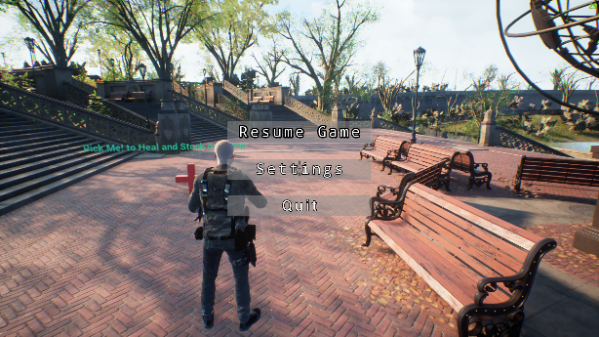Elite Soldier: The Final Fight

adventure
Role: Designer and Developer
Engine: Unreal Engine 5.1
Platform(s): PC (Windows)
Development Time: 1 month
Genre(s): Prototype(s) – shooting, adventure, role-playing.
Mode(s): Single-Player
Release: January 2023 (Master’s Dissertation)

Theme and Setting
Elite Soldier: The Final Fight combines the immersive realism of CS:GO, the stealth intrigue of Hitman, and the narrative power of Universal Soldier. Players assume the role of Sergeant John Thompson, a genetically enhanced soldier on a mission to eliminate rogue super-soldiers wreaking havoc across a modern urban landscape. Featuring a detailed open-world environment, skill-based gunplay with a realistic recoil system, and a narrative-driven mission structure, the game offers a cinematic yet tactically engaging shooter experience.
Core Gameplay
Third-Person Movement:
Players control an elite soldier using standard WASD controls, with sprint, crouch, and jump functionality for tactical navigation.
Combat System:
Players use an assault rifle with two shooting modes—hip fire and aim-down-sights—enhanced by a skill-based recoil system for realism.
AI Behavior:
Enemy rogue soldiers patrol the area, detect players via sight and sound, and engage in combat by chasing and firing at the player.
Collectibles:
Health packs restore 20 HP; ammo crates replenish 30 bullets—used for survival and progression through objectives.
Damage System:
Balanced combat—enemy hits reduce player health by 1, while player bullets deal 45 damage to enemies, making the gameplay fair but challenging.
Objective-Based Progression:
Players complete missions by clearing enemy zones, guided by visual cues like barricades and decals.
UI & HUD:
Intuitive menus and on-screen indicators provide control options, game story, objectives, and gameplay feedback.
Audio Cues:
Realistic sounds for gunfire, environment, footsteps, and music enhance immersion and signal proximity to key areas.
Design Responsibilities:
Concept Development:
Defined the core game concept and merged influences from Universal Soldier, Hitman, and CS:GO to shape the gameplay and narrative direction.
Narrative Design:
Wrote the full backstory and player character origin.
Designed key plot elements and in-game lore (e.g., DARPA serum story arc, mission motivations).
Gameplay Mechanics:
Designed and implemented:
Third-person player mechanics (movement, crouch, sprint, jump, etc.)
AI behaviors (movement, gunfire, sound detection, aggressive response)
Gun system including reload, fire modes, and custom recoil pattern
Collectibles system (health and ammo pickups)
Level Design:
Created mission structure with progressive objectives and visual navigation aids (barricades, decals).
Balanced combat intensity by carefully placing enemy spawns, collectibles, and pacing.
UI/UX Design:
Designed all UI elements: Main Menu, Pause Menu, Settings Menu, HUD elements.
Defined intuitive player options and settings for gameplay immersion.
Development & Testing:
Game Development:
Used Unreal Engine Blueprints to implement all core gameplay systems.
Integrated high-fidelity Nanite assets to enhance the visual realism.
Testing & Quality Assurance:
Functioned as the lead QA tester to iterate on gameplay balance:
Tuned enemy/player damage values to prevent player frustration.
Ensured clarity and functionality across all game objectives.
Asset Integration:
Sourced and integrated all required assets:
Characters, weapons, animations, environment, audio, and UI elements from Unreal Marketplace and Quixel.
Ensured all assets were compliant with commercial use requirements.
Audio Design:
Implemented audio cues for:
Environment ambience
Gunfire and reloading
Player actions (death, jump, footsteps)
In-game music and event-specific sound cues
.png)








